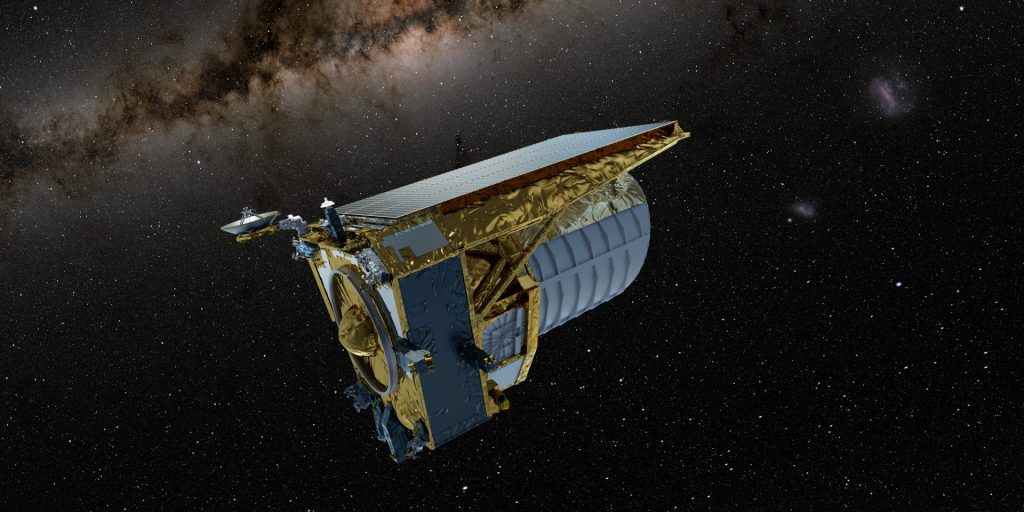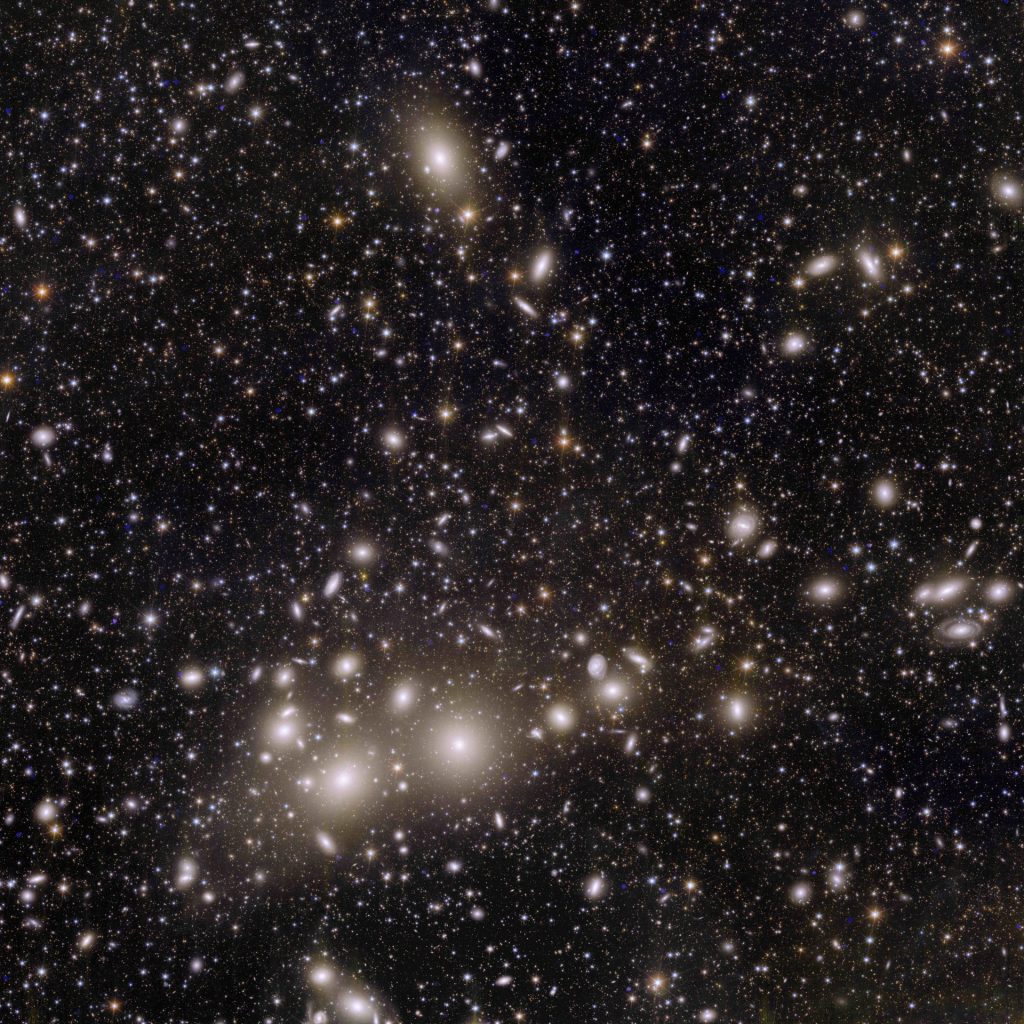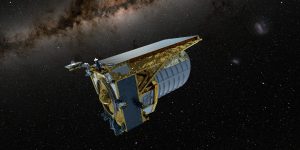The Euclid collaboration today publishes five reference papers on the mission and ten scientific papers based on the first images unveiled to the public in November 2023, as well as the new images presented today by ESA.
This phase of preliminary observations conducted last fall provides a glimpse into the telescope’s exceptional performance. The first scientific papers already reveal the discovery of newly formed rogue planets, the richness of the globular cluster population around nearby galaxies, the discovery of new low-surface-brightness dwarf galaxies in a neighboring galaxy cluster, the distribution of dark matter and intra-cluster light in galaxy clusters, and dozens of massive galaxies dating back to a time when the Universe was only 5% of its current age.
In parallel with these 15 articles, ESA today unveils five new images based on these observations, once again showcasing the sharpness of Euclid’s images and its ability to observe all scales of the Universe from the optical to the near-infrared domain over a wide field of view, more than twice the surface area of the full Moon.
The CEA plays a major role in the entire mission within the Euclid collaboration, from design and implementation to its scientific exploitation over the next six years. The CEA is also heavily involved in this scientific validation program for the telescope set up by ESA. Jean-Charles Cuillandre, an astronomer at the CEA-Irfu Department of Astrophysics, analyzed these first scientific data transmitted by Euclid to create color images and enable their scientific exploitation. He is a co-author of the 10 scientific papers detailing the initial discoveries, including 2 as the first author, one on the Perseus galaxy cluster and the other on image processing.
Five reference articles from Euclid
In collaboration with the European Space Agency (ESA), the Euclid collaboration, comprising 2600 people from 18 countries worldwide and with significant involvement from CEA, has planned, built, and is currently operating the Euclid space telescope mission. This mission aims to map the large-scale structure of our Universe over six years to constrain the nature of dark energy and the validity of general relativity on a cosmological scale. Launched on July 1, 2023, the telescope began its sky survey on February 14, 2024.
Five new scientific papers document Euclid’s performance and will serve as reference documents for the community interested in Euclid’s data and scientific results throughout the mission.
The first paper presents a comprehensive overview of the Euclid mission, covering its scientific objectives, spacecraft details, survey planning, data products, planned analysis, and more. Three papers describe the development and specifications of the two instruments onboard Euclid, VIS and NISP, and the calibration of the latter. Performance verification tests indicate that the telescope and both instruments are operating at expected levels. Finally, the last paper presents the “Euclid Flagship” collection of billions of galaxies based on the largest cosmological simulation ever conducted. These simulations are used to evaluate, calibrate, and correct systematic errors in Euclid’s data analysis methods.
“These five papers, totaling over 200 pages, represent both the culmination of more than a decade of efforts by the Euclid collaboration and the beginning of a new phase, that of Euclid science,” says Marc Sauvage, researcher at the CEA-Irfu Department of Astrophysics and chair of the Euclid collaboration’s science committee.

Ten articles from scientific validation data
The Euclid ERO (“Early Release Observations”) were obtained throughout the fall of 2023, totaling 24 hours of observation. The goal of this program is to showcase Euclid’s unique capabilities. Seventeen targets were observed, including galaxy clusters, nearby galaxies, globular clusters, and star-forming regions. A first set of five spectacular images was published by ESA in November 2023, which gained worldwide attention [See ESA’s press release from November 7, 2023]. A second set of five images is released today to celebrate the publication of the first scientific results as the scientific data is also made available [See ESA’s press release from May 23, 2024].
“The images and associated scientific results are impressively diverse in terms of astronomical objects and distances observed,” said Valeria Pettorino, Euclid project scientist at ESA and researcher affiliated with the CEA-Irfu Department of Astrophysics. “They generate a wide range of scientific applications and yet represent only 24 hours of total observation. These early observations clearly demonstrate that Euclid is up to the task ahead. We eagerly anticipate the next six years!” added Valeria.
Jean-Charles Cuillandre, an astronomer at the CEA-Irfu Department of Astrophysics, led this observation campaign for ESA with a group of scientists from the Euclid collaboration, from selecting astrophysical sources, processing raw data transmitted by Euclid, producing images, to their scientific analysis. Consequently, he is among the principal authors of the 10 papers and the first author of two of them. He is also responsible for the stunning color images.
One of his papers details the ERO program and the complete image processing chain specific to this effort, describing the extraordinary quality of Euclid’s data.
“The unprecedented images from this program have not only led to the first beautiful discoveries from Euclid that we are publishing today, but they also demonstrate that Euclid’s mirrors are nearly perfect!” exclaimed Jean-Charles Cuillandre. “This is a level never before achieved by an imaging telescope offering such a wide field of view at such high resolution thanks to its two large panoramic cameras. Euclid offers unparalleled capabilities to explore the Universe at different scales across a wide range of luminosities, thereby opening a new observational window in the near-infrared,” he added.

The Perseus galaxy cluster under the microscope
One of the six ERO programs was dedicated to studying the Perseus galaxy cluster by a team of 45 scientists from the Euclid collaboration, led by J.-C. Cuillandre.
“The Perseus galaxy cluster required the most significant observation effort among the 17 ERO fields: more than five hours were needed to reveal hundreds of previously unknown cluster galaxies. This is a very unique cluster because it is at an optimal distance to be observed by Euclid in a single pointing—an opportunity that will not occur again during the six-year mission since there are very few nearby clusters of this type in the cosmic web of the local Universe. Therefore, we know that the first three papers produced by our team on the overall properties of the cluster, its dwarf galaxies, and its intra-cluster light will remain relevant for a long time,” concluded Jean-Charles Cuillandre.
This cluster is one of the most massive structures known in the Universe. Located 240 million light-years from Earth, it contains over a thousand galaxies. An important feature of Euclid’s image of Perseus is the faint light clearly identified between the galaxies at the cluster’s core. This light is caused by wandering stars in the intergalactic void, resulting from the interactions between galaxies over billions of years. By studying this so-called intra-cluster light, scientists aim to trace the cluster’s history.
Matthias Kluge, from the Max-Planck Institute for Extraterrestrial Physics in Munich, Germany, stated, “This diffuse light is more than 100,000 times fainter than the darkest night sky on Earth. But it is spread over such a large volume that when we add it up, it represents about 20% of the cluster’s total brightness.”
Researchers characterized the galaxy population in this vast central volume of the cluster. This analysis revealed 1,100 dwarf galaxies, including 630 new identifications!
“The ERO images of the Perseus cluster demonstrate Euclid’s unique ability to detect and characterize large samples of dwarf galaxies, allowing us to build a detailed picture of galaxy formation and evolution across a wide range of mass scales and environments,” said Francine Marleau, a scientist at the Institute of Astronomy and Particle Physics in Innsbruck.
Euclid’s optical and infrared brightness measurements far surpass previous measurements, even though this is the most studied cluster of all time due to its proximity. The cluster’s properties were analyzed to derive the distribution of galaxies by brightness and stellar mass, revealing a specific diversity within the galaxy population, thereby providing insights into the underlying physics of galaxy formation and evolution.
“The unique data obtained from the Perseus cluster highlight the remarkable capabilities of the Euclid telescope. Our results differ from the predictions of cosmological simulations, providing new perspectives on galaxy formation and evolution. This unprecedented study also enriches our understanding of the universe’s structure and the evolutionary processes of galaxies in such dense clusters,” concluded Maëlie Mondelin, a Ph.D. student at the CEA-Irfu Department of Astrophysics.

Contacts Irfu/Dap: Jean-Charles CUILLANDRE, Marc SAUVAGE, Maëlie MONDELIN
Further information:
Euclid consortium press release
Euclid reference articles:
- Euclid. I. Overview of the Euclid mission, Euclid Collaboration: Mellier et al.
- Euclid. II. The VIS Instrument, Euclid Collaboration: Cropper et al.
- Euclid. III. The NISP Instrument, Euclid Collaboration: Jahnke et al.
- Euclid. IV. The NISP calibration unit, Euclid Collaboration: Hormuth et al.
- Euclid. V. The Flagship galaxy mock catalogue: a comprehensive simulation for the Euclid mission, Euclid Collaboration: Castander et al.
Euclid Scientific Early Release Observation Articles:
- Euclid: Early Release Observations – Programme overview and pipeline for compact- and diffuse-emission photometry, Cuillandre et al.
- Euclid: Early Release Observations – A glance at free-floating new-born planets in the σ Orionis cluster, Martin et al.
- Euclid: Early Release Observations – Unveiling the morphology of two Milky Way globular clusters out to their periphery, Massari et al.
- Euclid: Early Release Observations – Deep anatomy of nearby galaxies, Hunt et al.
- Euclid: Early Release Observations – Globular clusters in the Fornax galaxy cluster, from dwarf galaxies to the intracluster field, Saifollahi et al.
- Euclid: Early Release Observations – Overview of the Perseus cluster and analysis of its luminosity & stellar mass functions, Cuillandre et al
- Euclid: Early Release Observations – Dwarf galaxies in the Perseus galaxy cluster, Marleau et al.
- Euclid: Early Release Observations – The intracluster light and intracluster globular clusters of the Perseus cluster, Kluge et al.
- Euclid: Early Release Observations – A preview of the Euclid era through a magnifying lens, Atek et al.
- Euclid: Early Release Observations – NISP-only sources and the search for luminous z = 6 – 8 galaxies, Weaver et al.


